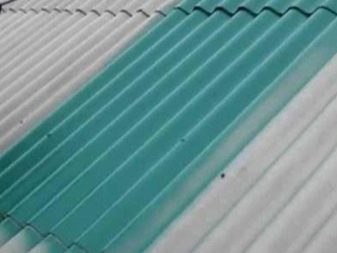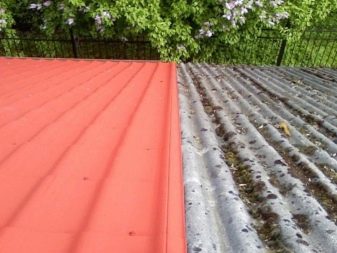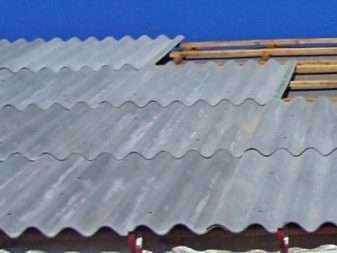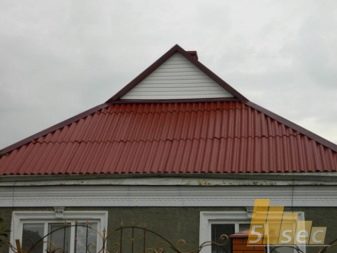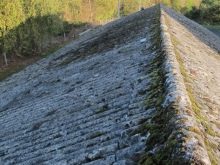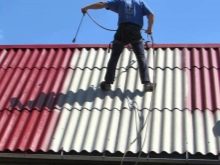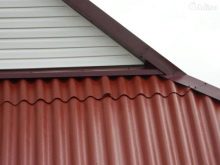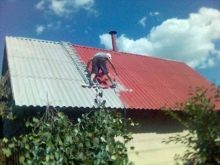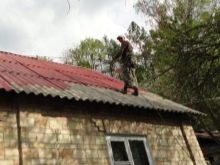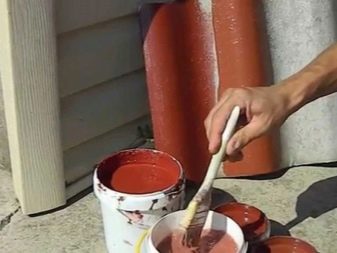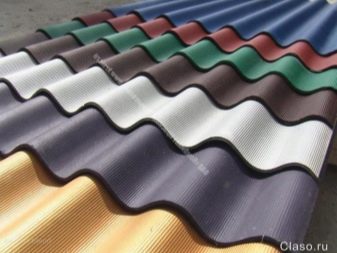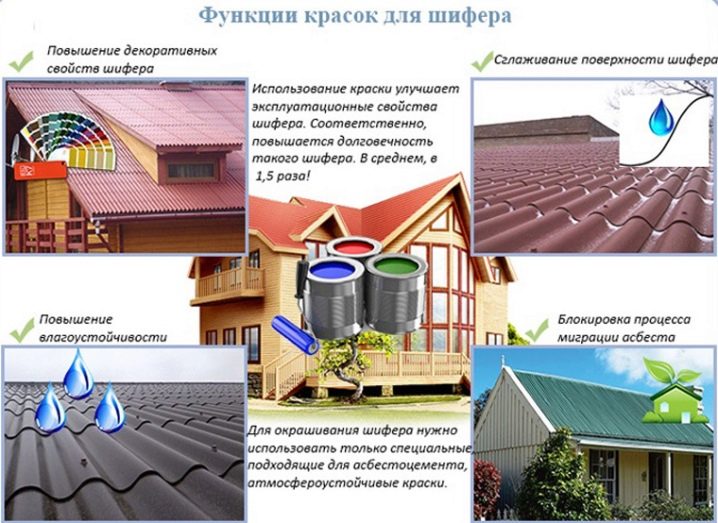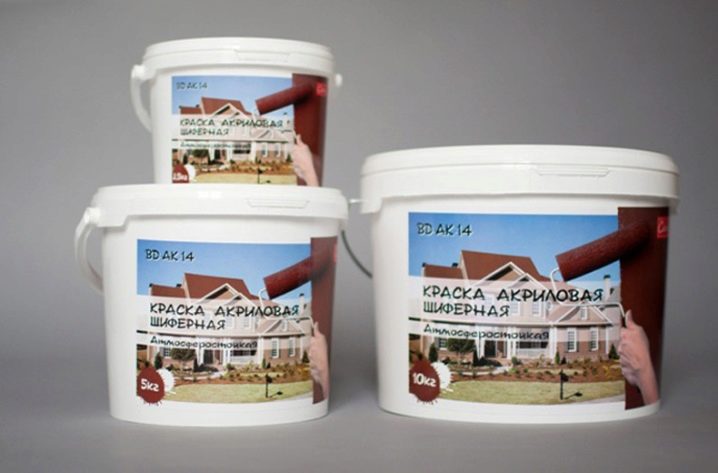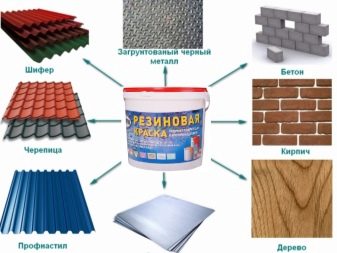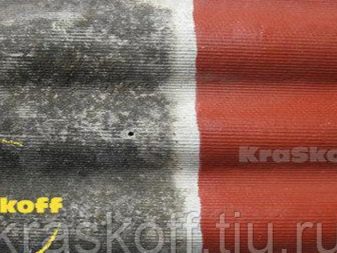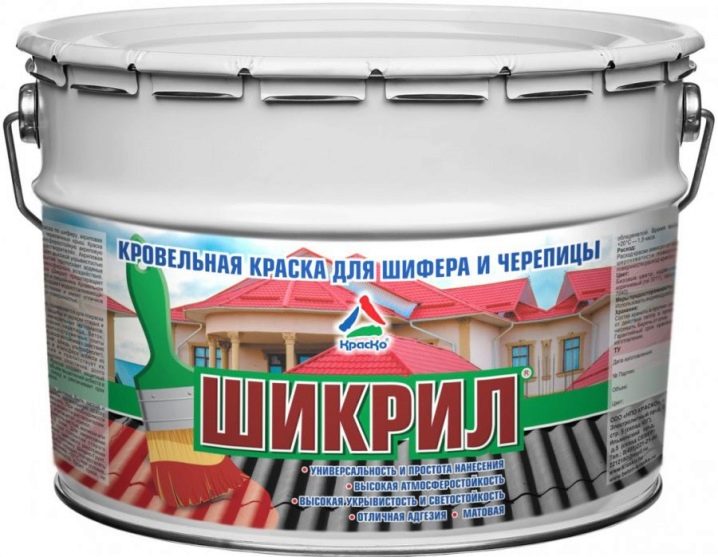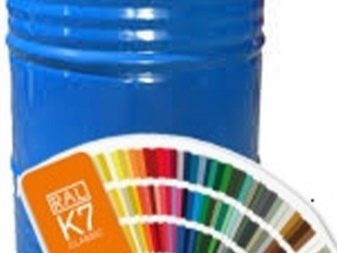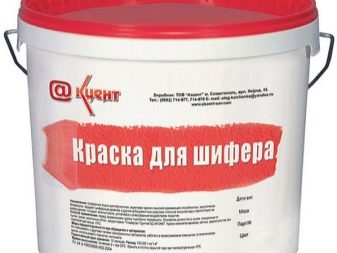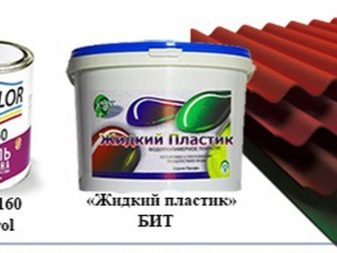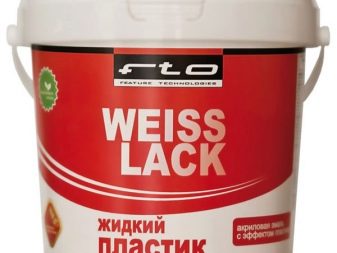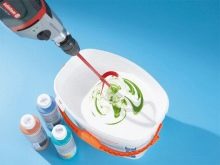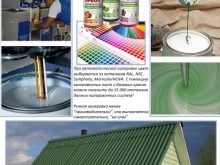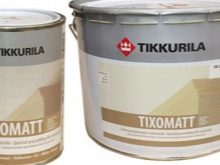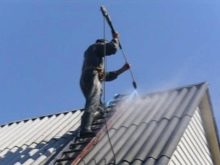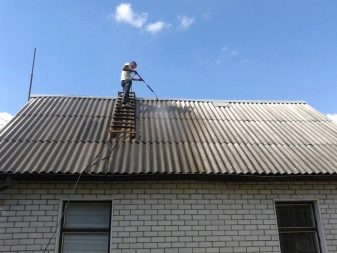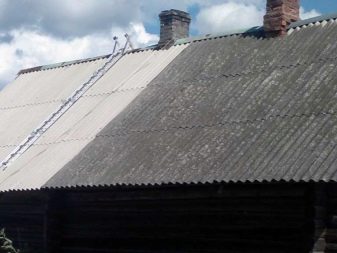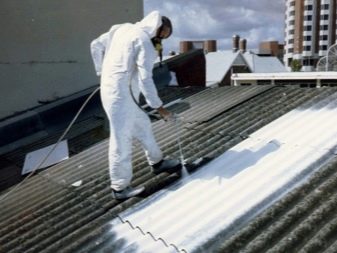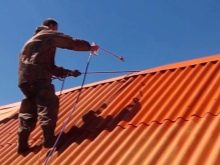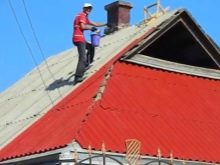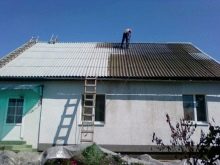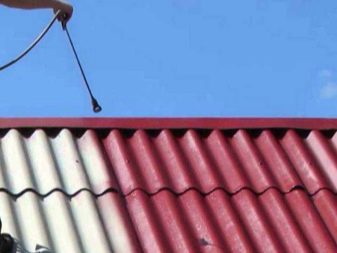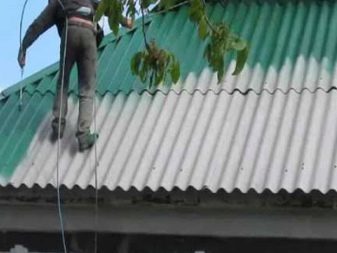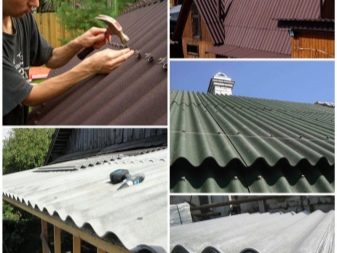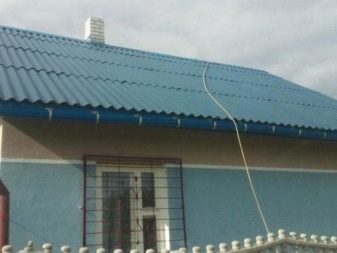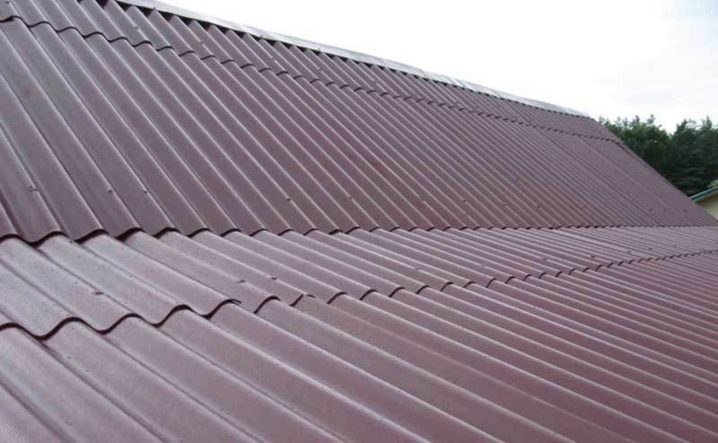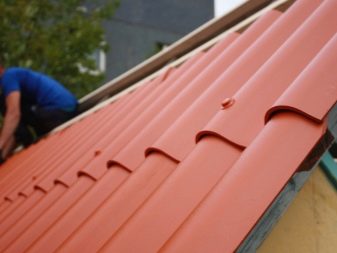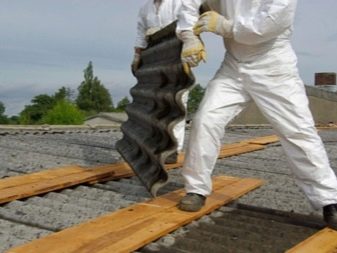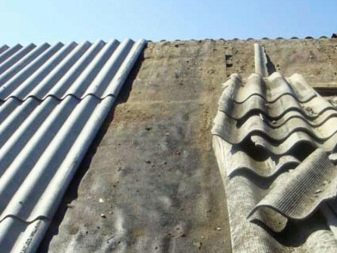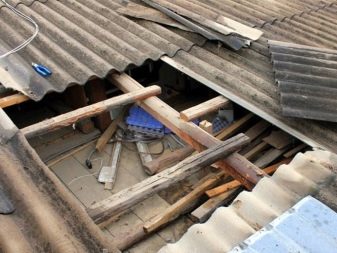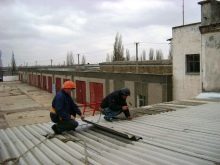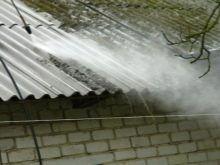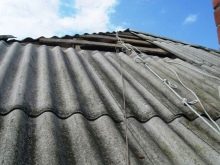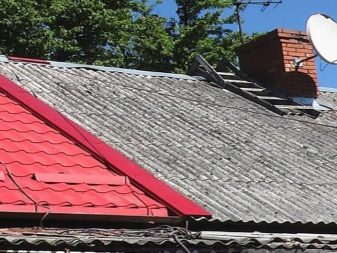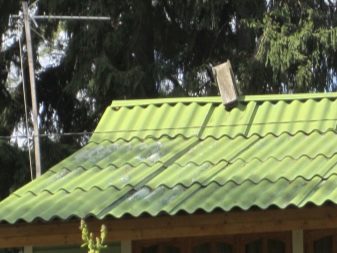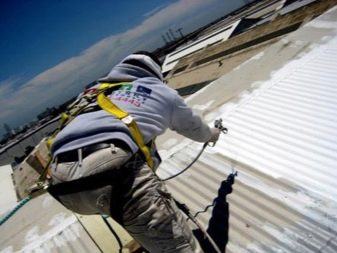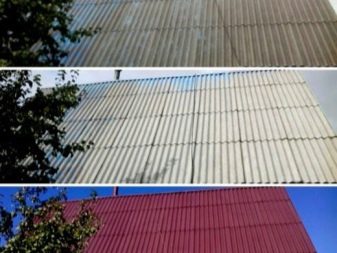Painting slate: the choice of colors and the nuances of the process
The years go by, and the appearance of the roofs of Russian houses is gradually changing, among them it is less and less possible to find options covered with inexpressive gray slate. But this durable and inexpensive material should not be discounted. To make it look no worse than modern roofing with a spectacular appearance, its “appearance” can be made more presentable.
Is it possible and why to paint?
Seeing slate in dull gray color in our country has become accustomed for a long time. Today, this color discourages people from buying such roofing, especially given the many alternatives available on the building materials market. But this does not mean that the slate can not be painted, giving it the missing gloss.There are varieties of colors that can be applied on a flat or wavy slate. The flat painted version will look great and expensive on the facade of the house, and the wavy one on the roof.
The use of paint is justified in terms of not only aesthetics, but also banal savings. This kind of improvement of the roof is possible, for example, in the case of overhaul. If we approach the correction of the situation in this way, the costs of updating will be small. This approach can also be used as a temporary measure in order to postpone for several years the question of a radical reorganization of the roof.
The coloring also solves many other problems.
- The paint binds asbestos dust, which is harmful to human health. Facades and roofs “dressed” in painted slate will be safe.
- Thanks to the applied paint, the waterproofing of the slate coating will improve, as the decorative layer fills micro cracks and pores on the surface of the material.
- Moss will not grow on the painted roof, which is a common problem for slate. Fungus and various pests that find shelter on the porous slate,also will not be able to settle on the roof treated with paint. As a result, the lifetime of the roof will increase.
- Paint slate can give any shade and to achieve a harmonious combination with the color of the walls of the house.
- The paint layer on the slate makes it smooth. From such a roof water flows more easily. There is no snow on it. It is easy to wash such a roof, as it should be spilled from a hose.
The only problem that can be encountered is that the staining will have to be repeated periodically. And this is not a matter of minutes. Although, on the other hand, without shifting the roof entirely, it is possible to “rejuvenate” it from time to time.
Select paint
To finish the slate appropriate paintwork should be selected very carefully. It should be resistant to strong temperature extremes, precipitation, do not dim for a long time, have good adhesion to the surface of asbestos cement.
There are the following types of paints:
- acrylic;
- silicone;
- alkyd;
- liquid plastic.
Consider the advantages and disadvantages of each type.
Acrylic paint
It happens on a water basis and on organic solvents. It has good waterproofing properties.When staining it penetrates into the smallest cavities and cracks, not allowing moss and fungus to multiply in them. Does not burn, adheres well to the surface.
It has no unpleasant smell. But at the same time it may have an excessively liquid structure and leave drips on the surface during dyeing. On the market you can find high-quality water-based acrylic paints of Russian, German, Finnish, Polish production.
For acrylic types of water-based is the so-called rubber paint. In contrast to the usual composition, it is a thick consistency mastic. Having dried, such paint turns into a film, on properties reminding rubber. It tightly engages with the roofing surface, not letting in water and not cracking.
This paint does not burn, dries in a couple of hours. However, with all the virtues it can not be called harmless. It is toxic, therefore, dealing with it, you need to properly protect the skin and respiratory tract. On sale it is called “Rubber paint”.
The second group of acrylic paints contains resin and solvent, which is usually white spirit.Depending on the percentage of resin, the degree of haze of the composition varies. The larger it is, the better the dried paint glitters with gloss.
This type of acrylic compared to the water-based version is different in that it forms a stronger film, repels water better, is also more resilient and is able to retain color longer. At the same time, such a paint has a very sharp unpleasant smell, which creates discomfort at work. The choice of such paint products on the market is large. Among the famous names often mention "Shikril" of Russian production.
Silicone paint
This variety is classified as the most durable and reliable for slate. Silicone makes the colorful coating elastic. When staining composition penetrates into the cracks to a depth of two millimeters.
During repairs, they repair quite large damages on the roof. This paint does not allow different microorganisms to multiply on the roofing material, it does not let water and dirt through. Non-toxic, fire safe. With it, the “lifetime” of slate increases by about five years.
It keeps perfectly on the surface of the roofing material, but in ten or fifteen years it burns out strongly, losing its visual appeal.It should be borne in mind that the price of such roofing paint is quite high.
"Liquid Plastic"
It is a polymer paint, which, after hardening on the surface, is transformed according to its own name into a layer of plastic on the slate. Externally, it may look dull or glossy. "Liquid plastic" completely isolates the roofing material from water, dries quickly after application.
The paint is environmentally friendly, does not burn, does not lose color, is resistant to severe frosts. You can work with it at temperatures up to -10 degrees. It will last ten to fifteen years. The disadvantage of "Liquid Plastic" is that it is toxic. Requires protection of the skin and respiratory organs during application to the surface.
Alkyd paints
Created on the basis of alkyd resins and organic solvents. They dry quickly, creating an elastic film on the surface that does not crack. Well mate with slate, reliably protect the roof from water.
This paint also does not require pre-priming. The service life at the same time is small - only five years. In the market there are good alkyd paints of foreign and domestic production.
Usually for coloring slate choose green, red and brown colors., they are the most common, but sometimes you want something special. In such cases, tinting comes to the rescue - a process where the necessary shades are obtained by mixing pigments or paints. Tinting services are offered by paint manufacturers. You can also achieve the desired color by yourself. To do this, add coloring paste to the existing paint and stir using a mixer.
Surface Preparation: Tips
The success of staining slate roofs largely depends on the preliminary preparation for this process.
- In order for any selected paint to hold firmly for many years, the slate plates must be thoroughly cleaned. You can remove all dirt with a metal brush. We will have to make a lot of effort to remove from the roof all the dust, stubborn moss, old leaves and branches. It is necessary to be engaged in such work on a fine day. Wet slate is a rather fragile material, so after rain it’s better not to clean it.
- With skillful possession of the tool, you can use the grinder with a nozzle for grinding.In this case, it is important not to overdo it with pressure, otherwise the roof can be damaged. Working with such a tool will not speed up the process, but the quality of cleaning will be much higher.
- The easiest and fastest way is to remove all the dirt from the roof with water. Serve it should be under pressure from 200 to 250 atmospheres. If the jet is weaker, not all the dirt will come off, and if it is stronger, slate will break.
- Whatever cleaning method is chosen, it is necessary to work in overalls, goggles and a wet respirator, since released asbestos dust is dangerous to humans.
- Before applying a layer of paint, it is also important to protect the slate from the effects of fungus and parasites, which are embedded in the structure of the material and eventually destroy it. If the roof is simply painted, this process will not stop. The paint will begin to peel off, and an unpleasant black or whitish coating will appear on the slate.
- Slate must be treated with antiseptic, which has a profound effect on the material. It may be a general purpose antiseptic or a special treatment for slate.
- Processing can be carried out with a brush, roller or spray.It is useful to apply antiseptic on the roof several times.
- After completion of the procedure, the composition should be absorbed into the slate and dry.
- The next stage is surface treatment with a water-repellent compound, since water is exactly what primarily affects the porous structure of the slate coating in a negative way.
- At the next processing stage, a primer is applied. It makes the surface smooth, removing microcracks and roughness. In addition, if priming is not carried out, the binder, which is part of the paint, is absorbed into the porous slate, and the decorative coating will not be able to hold firmly. In addition, thanks to the application of the soil, it will be easier to coat the slate with paint, its consumption will be less and it will lie evenly.
There are special primers, among which the most effective are acrylic. They penetrate the deep layers of slate, strengthen the surface and fill the pores.
You can also use the paint itself as a primer, which you plan to cover the roof surface.. It is diluted with solvent. When processing the surface of such a soil penetrates into the upper layers of slate, fills microcracks and pores.Due to this, a layer of ordinary paint fits tightly to the base.
It is possible to carry out priming both in +5 and in +30 degrees. It takes about twelve hours to dry the primer, then paint can be applied.
Coloring: features
You can do this work without the involvement of a specialist, as they say, with your own hands. It is best to apply the paint in two layers, as advised and craftsmen and professional finishers. One will be the base, and the second finish. The base layer must carefully cover the entire roof or surface of a flat slate on the facade, including the ends, corners and other details of the structure. It takes two thirds of the total volume of paint.
The second layer is applied after the first has dried. Thanks to him, the roof and walls get a uniform color. For work, you can use a brush or spray. Experienced people do not recommend using a roller, because in this case it is inconvenient. It is best to paint with a spray gun, but it will not be possible to do without a brush in the corners and joints.
For such work, it is advisable to choose a warm and overcast day, not foreshadowing precipitation. It is important that the next one is the same.If it is wet or too hot outside, painting is impossible. On average, one square meter of area, subject to the application of two layers of coating, consumes one hundred two hundred grams of paint. But the material should be purchased with a margin in case of additional costs.
And now we will consider the nuances connected with coloring of different slate.
New
Obviously, with a new slate coating device, all work related to the guidance of beauty is best performed on the ground. Experienced people advise to separate this process: apply a finishing coat of paint already on the roof, because during the installation of the roof, pre-painted sheets of material can be scratched.
Although again, everything will depend on the specific situation. If the roof area is small, the slope is not strong and real professionals have taken up the job, the risk of damaging the surface of the painted slate sheet is significantly reduced. Sometimes it is easier to do all the steps of the paint treatment on the ground, and then fix the damage in some places on the roof surface.
Old
With the old slate will be much more. Often, when it comes to painting the roof, which has been in use for many years, its construction itself is already weakened.Stepping on it, you can break through the slate, or at least provoke the appearance of new cracks on it. Over the years, this roofing material becomes loose. So that being on it can be dangerous.
Before works directly related to painting, it is necessary to carefully examine the surface of the roof. On the old slate there are longitudinal and transverse cracks, breaks. Sometimes damaged roofing sheets are easier to replace, although you can restore them.
Longitudinal cracks on the slate usually have a microscopic width. To prevent such damage from causing further damage, a tape of fabric, pre-immersed in waterproof glue or enamel, is glued to this place, which will then be painted on the roof. You can also do with small transverse cracks and places where the slate begins to stratify.
To seal the gap, it is necessary to use the composition of dissolved asbestos, PVA glue and cement. Only after complete drying of this mixture can further action associated with the color.
There will be much more pollution in the form of moss and mold on the old roof than on the onethat mounted recently. Moss grows particularly strongly on the north side. To remove all the excess, you have to work hard. But the result after the completion of staining, if all stages of work are carried out with due care, will be very pleasant. Instead of the old, dull gray roof, you can get a reliable and elegant roof covering that will look like a new one, made of more modern and fashionable materials.
Paint life and reviews
Despite the fact that manufacturers of paint for slate predict the approximate duration of its service, the fate of such a coating on a particular roof or wall will depend on many factors. This is evidenced by reviews of people who "modernized" slate roofing using paint.
- Pigment. If it does not differ in quality, it has a slight resistance to sunlight, such a colorful coating will cease to be saturated fairly quickly.
- Binder (i.e. film-forming substance in paint). If it is weak, it will not be able to preserve the pigment on the surface of the slate roof. As a result, the paint will go unevenly.
- Primer. Without such a layer on the loose and porous surface of painted slate, most of the paints keep worse and their service life is noticeably reduced.
- The quality of the preparatory work. If dust and dirt are removed poorly, the paint will not be able to connect well with the surface on which it is applied.
- The quality of staining. A thin layer of paint stays on the slate worse than thick. At the same time, excessively thick layers create a film that can crack under the influence of humidity and sudden changes in temperature.
- Exploitation. If water often stagnates on the roof, frost forms in the off-season, and in winter snow and ice often slips, this affects the quality of the paint coat.
As practice shows, the outcome of the plan for the painting of slate roofs largely depends on the integrity of those who undertake this business. There are cases when with the snow after the first winter there are visible traces of paint damage. But if you approach the work thoroughly, then the slate can look elegant, high-quality and stylish for ten or twelve years.
Video instructions for painting slate, see below.

